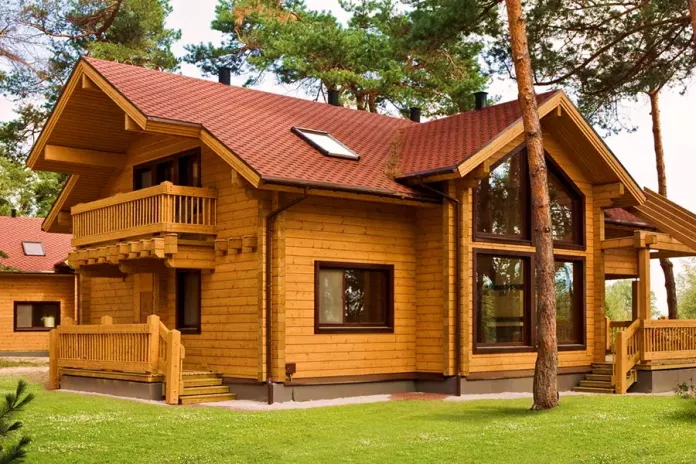Wooden House - the Perfect Home
A wooden house is an ideal home for any person. Traditionally, houses were made of natural material - wood, and, with the right work on their construction, they served for many years. Unfortunately, now most people live in concrete buildings, which do not correspond well to the parameters that a person needs for normal life and maintaining the body in a healthy state. A wooden house most closely complies with all medical standards and requirements for living conditions, being in its own way an ideal variant of a dwelling. The wooden house has excellent thermal insulation. The wooden walls of the log house provide thermal insulation three to five times greater than the thermal insulation properties of brick or concrete of the same thickness.
One of the main advantages of a wooden house is that the material from which the house is made passes air well, and, being a natural material, saturates it with substances useful for the body - phytoncides, which destroy viruses and bacteria that are harmful both to the wood itself and man. In addition, phytoncides ionize the air, reducing pollution and disinfecting it. Coniferous trees emit much more phytoncides than deciduous ones, so wooden houses made from pine or spruce are much more useful for people who have any problems with the respiratory tract.
A very important factor affecting human health is the humidity in the room in which he lives. The range of humidity required for comfortable living is 40-60%. Modern residential buildings with central heating do not meet these parameters, usually the humidity in them is much lower than normal. As a result, people develop acute respiratory diseases caused by drying out and irritation of the respiratory tract due to low humidity in the room. A wooden house provides a constant humidity in the winter and summer in the range of 45-55%, ideally corresponding to the humidity required for a person.
It has been scientifically proven that people living in a wooden house normalize their blood pressure, their lungs work better, and such people are less prone to stress. Constant visual and tactile contact with wood has a positive effect on the emotional state of a person and his well-being.
Wooden Houses Construction Technology
Log cabin "in the paw"
Log cabin "in the paw" - a classic style of felling, characterized in that the ends of the logs do not extend beyond the walls of the log house. The name "in the paw" comes from the way the ends of the logs are connected - in this type of felling, the log has a tetrahedral ending - "paw". The technology of cutting "in the paw" has both advantages and disadvantages. The advantages of log cabins made by cutting "in the paw" include their lower cost and the simplicity of additional insulation of the outer side of the walls of a wooden house. There is only one drawback of felling "in the paw" - the corners of the house turn out to be colder, since the end part of the logs is relatively close to the inner surface of the walls.
From the technical point of view, felling a log house "in a paw" is a more difficult option for making a log house than cutting "in a bowl", since it requires high precision in the execution of work on the manufacture of a log house and highly skilled workers. When felling a log house, special attention is paid to the selection of logs of the required quality and dimensions, but there are practically no losses along the length of the log, which makes this more complex method of felling a log house economically viable and in great demand. But it is worth remembering that insufficient qualifications of workers or inaccuracies in the manufacture of a log house can lead in the future to the fact that it will be purged, and it will be almost impossible to fix this.
Log cabin "into the bowl"
Log cabin "into a bowl" - the most classic style of felling, its roots go back to the depths of centuries. A wooden house, cut down "in a bowl", is distinguished by high strength and good thermal insulation of the corners. A distinctive feature of a log cabin made by cutting "into a bowl" is the protruding rows of log ends at the corners of buildings. Due to the way the logs are connected, the log cabin, made by cutting “into a bowl”, is well protected from the effects of atmospheric factors - cold, rain, snow and wind, since the corners of the house are reliably covered by the ends of the logs protruding to a great length.
For the manufacture of log cabins, round logs were traditionally used, and with the “bowl” cutting method, a classic look of a wooden structure is obtained with rows of end parts of the logs at the corners. Cutting "into the bowl" can be carried out both with the bowl up and with the bowl down. When cutting "into a bowl" in logs, at the place of their connection, a semicircular recess is made half of its diameter, a groove is made on the bottom side of the log. The logs connected by cutting “into the bowl” are securely fixed from displacement, while it should be noted that hand-made log cabins usually have a “lock” at the junction of the logs, which is not the case in the “bowl” structures of rounded logs manufactured on industrial machines. As a result, the corners of a handmade log house are warmer, stronger and more durable than their industrial counterparts, which is a serious argument in favor of a handmade log house.
